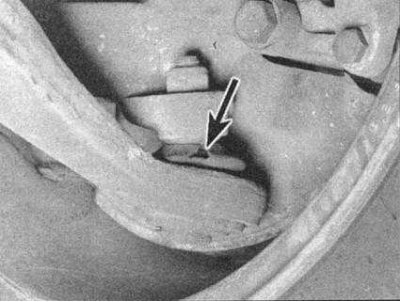Note. Steering and suspension components should be checked regularly. Worn or damaged suspension and steering components can cause excessive and dangerous tire wear, poor ride and handling, and increased fuel consumption. For more detailed information on the components of the suspension and steering system, refer to the Chapter Suspension and steering.
Checking the suspension strut
1. Park your vehicle on level ground, turn off the engine, and apply the parking brake. Check tire pressure.
2. Press one of the corners of the car, then release it, paying attention to the movement of the body. It should stop swinging and return to its original position after one or two swings.
3. If the vehicle continues to rock or does not return to its original position, a worn or loose suspension strut may be the cause.
4. Repeat the above procedure for each of the three remaining corners of the vehicle.
5. Jack up the vehicle and place it securely on jack stands.
6. Inspect the struts for signs of hydraulic fluid leakage. A light film of liquid is not a cause for concern. If a leak is found, make sure that the fluid is coming from the rack and not from somewhere else. If it is still a strut leak, replace the struts in pairs on the same axle (or all four).
7. Check the reliability of the installation and the integrity of the racks. Check the upper strut mounts for damage and signs of wear. If any are found, replace the racks.
8. If it is necessary to replace the stands, refer to Chapter Suspension and steering. Always replace both components on the same axle, otherwise the vehicle's safety may be endangered. If possible, try to replace all four components in the kit.
Checking the condition of the steering and suspension system
1. Examine components of system of a steering on presence of damages and deformations. Look for signs of fluid leakage, damaged gaskets, boot guards, and fittings.
2. Clear the bottom end of a rotary fist. Ask an assistant to grab the lower edge of the wheel and shake it, while you yourself observe the movement of the ball bearings connecting the steering knuckle to the lever. Inspect the protective covers of the ball joints for breaks. If you find play or torn or leaking protective covers, ball joint (supports) should be replaced.

3. Inspect ball joint protectors for tears (indicated by an arrow).
4. Grab each of the front wheels by the front and rear edges and try to turn it front in and rear out to check for play in the steering gear. If play is found, check for loose steering gear and tie rod joints. If fasteners are loose, tighten them. If the tie rods are loose, worn joints may be the cause (check the tightness of the nuts first). Additional information on the steering system and suspension can be found in Chapter Suspension and steering.